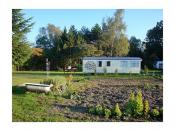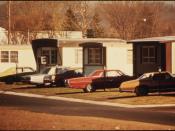The Buyer Decision Process: What It Is All About
The buyer decision process is the steps the consumer takes before and after making a purchase. There are five stages to this process, realization that there is a need, a search for information, evaluation of alternatives, the decision to purchase, and post purchase behavior (Armstrong & Kotler, 2007). In the following paragraphs I have taken two subjects who have recently purchased used mobile homes. I will discuss the buyer decision process they went through in making their decision. I will compare and contrast each aspect of the process, and discuss some of the personal characteristics that went into the final decision. I will also discuss how their demographics affected their decision.
The Subjects
Subject #1 is a disabled 41 year old female, currently living with a boyfriend in Dover Pennsylvania. Her income level lies within the $10,000 to $20,000 range.
She has recently bought a remodeled 1972 Monarch mobile home in the Dover area to live in. She was living in a basement apartment when her landlord decided to sell the home, and gave her a thirty day notice to vacate forcing her to find alternate housing. She was actually looking for another apartment to move into, but faced with a recent bankruptcy was unable to acquire one because of credit checks. So she started looking at cheap used trailers knowing her father would either co-sign for a loan or lend her the money. Not wanting to count her boyfriends income in case they would break up, she wanted to be able to afford the trailer on her own so she did gave herself a limit of $20,000. She decided the best way to find a cheap trailer was to avoid the cost of realtors. So she drove around mobile home parks looking for "For Sale" signs. After calling around, she found one for $19,000, it was very nice, but she did not like the layout of the bathroom at all, so decided against it. It was then that she discovered that even with a co-signer would be unable to acquire financing. So she started looking at even cheaper ones, finding one for $10,000. This one needed a lot of work, it was a fixer upper. Keeping that trailer in mind she still looked at others. It was then that she came across a mobile home for $6,000. The cheaper mobile home was recently remodeled, and though it was kind of small it was nice. After talking with the owner, subject #1 made a mental connection with him so he lowered the price to $5,000 just for her. Talking it over with her friends that she had brought along, they decided it was a good deal, and the park was situated in an area she wanted to remain. So she bought the $6,000 mobile home for $5,000. It was not an ideal choice for her, but was within her budget. She has no regrets in her decision as it is exactly what she expected when she bought it, and the compromise of not putting herself back into a debt she could not afford was worth it. The only post purchase regret she has is not being able to afford something nicer.
Subject #2 is a divorced 65 year old female, living in Kissimmee Florida by herself. She is currently employed by Disney and has a yearly income range of $30,000 to $40,000. She has recently bought a 1990 Jacobson mobile home located in a 40+ community to live in. Her decision to move came when she realized she was in over her head in debt, and wanted to be able to retire soon. Being of retirement age she wanted to be debt free before she did. So in order to pay off all her bills, and still have money to purchase a home, she decided to sell her house and buy a mobile home in the price range of $40,000 to $65,000. Not being in a big hurry, she took her time driving through different mobile home parks, and searching the internet to help her locate what she was looking for. She was looking for a nice size mobile home, with a layout she liked, in an adult community, near shopping malls, and work. She narrowed her search to four mobile homes that she really liked. The first being $69,000 was a little out of her price range, so she ruled it out. The second was a 1986 model that was only $42,000; it was a nice mobile home in good shape, in a nice park. She did not like the fact that the washer and dryer were out in the shed, and realized she would have trouble insuring the place because of the age of the home. After talking it over with family and friends, she decided against it. The third home was a gorgeous mobile home with a layout she loved for $55,000. After putting money down on this home she realized, even though the park was a 55+ community, she did not like it, or the lot the trailer was on. There was no landscaping, no carport, and the driveway was not paved. So she decided on the fourth and final trailer. The 1990 Jacobson had a large carport, hurricane shutters, and a great layout. It was located in a 40+ community that she found pleasing and the lot was very well landscaped, with a reasonable price of $51,000. The trailer and the park have met all her expectations and she does not feel she compromised anything in buying it. She said it was the "best buy for the money".
Comparing and Contrasting the Buyer Decision Process
Both subjects recognized a need to find a new home. Subject #1 was driven more by an internal stimuli, the need for shelter which drove her to find a place more quickly. Subject #2 was more of an external stimulus. The need was not a necessity; it was based on opinions of friends and family to help her come up with a solution to her money problems, which gave her the freedom to take her time.
Neither subject did any research on brand names; both were more focused on price. In finding a mobile home both used a drive by method looking for "For Sale" signs, which could be considered a commercial source because "For Sale" signs are ads. Subject #2 also used a public source, the internet, where she found the trailer she ended up purchasing.
In evaluating the different mobile homes, both subjects narrowed their search immediately by price first, looking at price for quality. This was subject #1's main concern in her purchasing decision, where subject #2 also looked for certain features and amenities when making hers.
In making the purchasing decision, subject #1 was drastically affected by situational factors. When she claimed bankruptcy it left her credit impaired, leaving her with a limited number of choices. Without this factor she might have chose to move into another apartment or a larger, newer mobile home. Although finances were a factor in subject #2's decision to buy a mobile home, they were not a major factor in her final decision. Both subjects were influenced by attitudes of others, by giving their opinions. With subject #1, her decision also came from the amount her father was willing or able to lend her.
Both subjects were pleased with their purchases. The mobile homes met with the expectations they had when the initial purchase was made, and neither have little or no post purchase conflict. Subject #1 expresses that she wishes she could have afforded better.
Characteristics and Demographics
With subject #1 I would have to say that economics played a key factor in her purchasing decision. Faced with a desperate situation at a bad time in her life, her age and life-style had nothing to do with the actual purchasing decision, but maybe played a key role in her post purchase dilemma of wanting better. Although her economic situation left her with few choices, her close ties to family gave her the ability to purchase, because of her poor credit and low income level.
Subject #2 was put into a position where she could stay with what she had, and struggle financially through her retirement years, or make a change that would put her in a position she where she could live more comfortably. She chose the later of the two. Demographics and personal factors played a key role in both her decision to move and where she moved. Her age, and her need to retire was the reason she decided to move and also affected the type of park she wanted to move into. Where she worked was also a factor in location of park. Her economic status was a large factor in determining price range. Her culture, lifestyle, and personality all played a part in considering style and layout of the mobile home she ended up purchasing.
Conclusion
So in conclusion because of Subject #1's situation not many characteristic and factors played into her decision process, but she still followed the stages of the buyer decision process. On the other hand there were a lot of characteristics and factors, such as age, demographics, economics, culture, etc, that played into Subject #2's decision process leaving her with better choices and advantages then subject #1.
Reference:
Armstrong & Kotler, (2007), Marketing an introduction, Upper Saddle River, NJ, Pearson Prentice Hall.
Appendix
Questions
1.Age
2.Location
3.Income Level
4.Race
5.What kind of need came about that caused you to decide to move?
6.What made you decide to buy a trailer?
7.How did you locate your trailer?
8.Did you have any help in deciding which trailer? Such as personal sources, commercial sources, public sources?
9.How did you compare different trailers? What were you looking for? Did location have anything to do with you decision?
10.Did you purchase the mobile home you first decided on? If not why, did someone talk you out of it, or did a situation occur which changed your mind?
11.Are you happy with the mobile home you purchased? Is it what you expected?
12.Are you happy with the compromises you made in choosing your trailer


